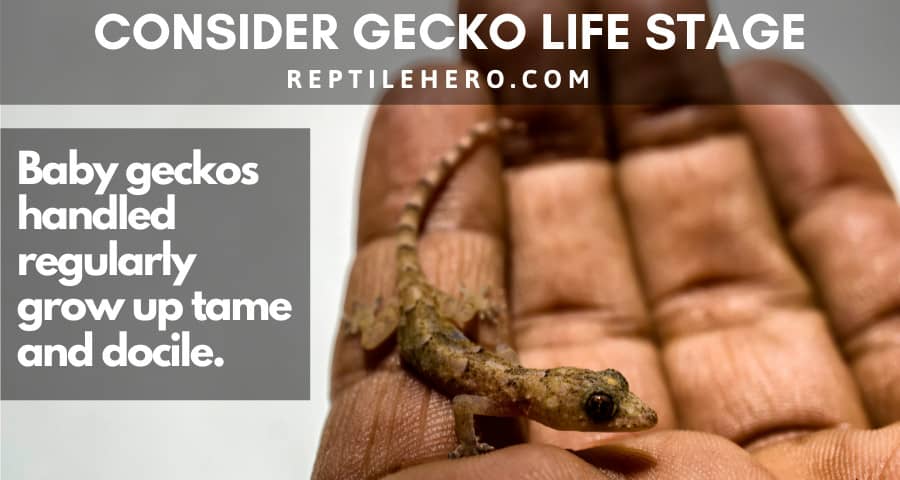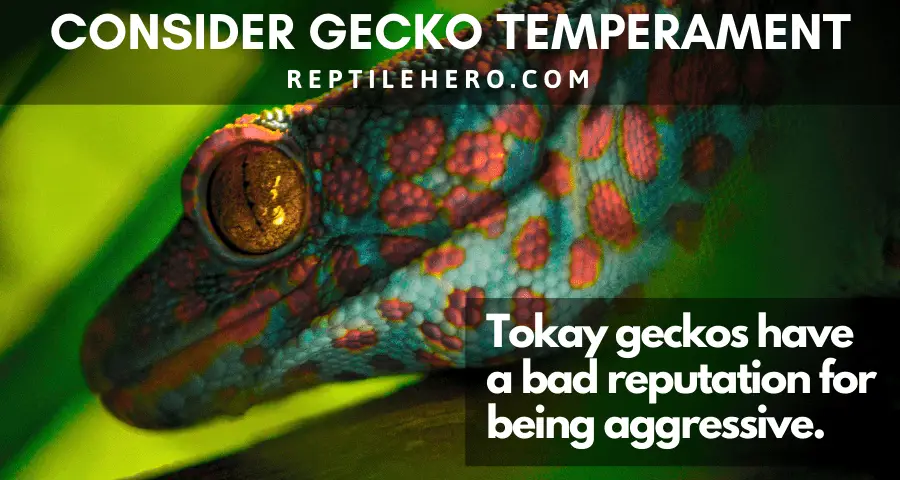How To Properly Handle Your Geckos [6 Facts and 4 Tactics]
There are two kinds of newbie hobbyists; one is the type to overthink and over-prepare while the other is the type to just take things as they come. So when it comes to picking up their first-ever gecko they’d go about it quite differently. But whichever type of gecko enthusiast you are, there are a lot of important things you need to know about proper handling.
Consider these 6 factors before holding geckos: stress, age, past, vigilance, time, and temperament. The 4 basic steps of proper gecko handling are as follows: recognition, exposure, skinship, and lifting. Lastly, it is still unclear whether geckos do, for a fact, enjoy being picked up by humans.
Come and pick up all the info you could possibly get on the topic as I explain the basics.
Gecko Handling: 6 Important Facts
First times for anything tend to be overwhelming and nerve-wracking. It’s completely understandable for you to feel unsure and reluctant about handling your very first reptile baby. After years of learning – based on personal experiences and those of other keepers – from hands-on practice, I consider the following as the most crucial factors that could ensure your success.
Let’s start with the things you should consider first before even attempting to pick up your precious little friend. The list below is definitely something for you to keep in mind. They will not only be helpful for your first gecko, but for all the others to follow as well.
#1 – Adjustment Time
On average, geckos will need more or less 2 weeks to adjust to their new environment – that includes their enclosure, you, your home, and other pets and people who may be living with you. Some species may take longer to get comfortable so just sit tight, the time will still come.
During this period, it is important to leave them to themselves to not make them feel any more distressed than they already are. That is of course, with the exception of feeding.
However, some geckos normally still don’t eat or drink much, at times not all.
If the little guy (or girl) still isn’t eating, drinking, or moving days after the 2-week mark, it’s best to schedule an appointment with your local exotic veterinarian to see if there’s anything wrong.
#2 – Age Matters

Hatchling and juvenile geckos are more high-strung than adults. They will stand taller to make themselves look bigger, scream at you as a warning sign to not come any closer, or simply go glass surfing because they feel agitated.
They are also much more fragile and prone to dropping their tails while still in their formative years – or, well, months to be more exact. So it’s important to be extra careful when dealing with them. Be light-handed and gentle.
But if you do get to tame them early on in their lives, they can grow to be incredibly docile and even chummy with you. So if you do want to get a reptile as a pet, buy hatchlings or juveniles.
#3 – Past Influences Present
Some people choose to get adult geckos for their first reptiles, thinking that they would need less attention and tending to. I’ve even met prospective hobbyists who claim that it’s better to get older geckos in general because they are 100% tame and docile.
Although there is some truth to that – specifically with geckos lovingly raised and trained by breeders – it is not always the case.
Previous experience with humans is significantly influential to their future behaviors towards you as their new owner. You can expect a gecko who was a wild-caught or has experienced abuse and neglect in the hands of previous keepers to have negative attitudes towards you.
Since such attitudes have already been deeply ingrained into them, it will be more difficult to get them comfortable with or accepting of you, much less form a bond with you.
#4 – Extreme Vigilance
Whether geckos are captive-bred or wild-caught, they have an innate tendency to be on high alert most of the time. You can attribute this to the fact that they are prey to numerous bigger animals in their natural habitats.
So you, being a big and unfamiliar beast in their eyes, will naturally make them feel as though they are in danger. They could scurry off to conceal themselves inside their hides or come at you for a nasty bite.
#5 – Time of Activity
Another important fact to take into consideration is that different gecko species are active at different times of the day. This is more formally called the temporal niche. It can be used in a number of contexts such as the tidal cycle.
When it comes to lizards and other reptiles though, temporal niches are based on the 24-hour solar day cycle [1]. There are 4 common variations among geckos when it comes to this temporal pattern of activity:
- diurnal – during the day
- nocturnal – during the night
- crepuscular – during dusk and dawn
- cathemeral – during different times of the day
I’d suggest you look into geckos to match your own activity time patterns. You wouldn’t want to wake up geckos during their usual times of rest unless you want them cranky and unhappy. Imagine someone waking you up in the middle of a good night’s sleep just to play around with you. Wouldn’t you be upset by that as well?
#6 – Temperament

Once you get a chance to chat with experienced owners and experts, they’d probably tell you all about how the geckos in their care have unique tendencies and personalities. This, of course, is true among different species.
If you are on the shy side of the social spectrum, leopard geckos and crested geckos are great for beginners. Although they do have their fair share of differences, they are both generally calm and docile when it comes to handling.
Tokays, in particular, are infamous among new and long-time gecko keepers because of how aggressive they can be. You’d need a good glove for protection whenever handling adult geckos of this species. So if you’re up for the challenge (and possible dangers), by all means, get one for yourself.
Start With The Basics (4 Simple Steps)
In a past article, I’ve briefly talked about what I like to call touch training. So I’m just going to go over it again. But this time, in greater detail.

#1 – Make them Recognize You
By you, I mean all of you: your scent, voice, presence, and movement. It’s best to do this right off the bat when you bring your gecko home for the very first time.
While inside a quarantine tank or their vivarium, help them settle in and make them feel safe with you around. One way to do this is by placing a worn (but not dirty) piece of cloth with your scent on it in their new home before directly letting them smell you after the adjustment period.
You should also talk to them, hum a tune, or set a certain sound – a tap on their enclosure or a click of the tongue – whenever you are near them.
And just being around their enclosure while going about your day, as usual, working, doing chores, reading, listening to some music, and all that can also be of great help in getting them acquainted with you.
While you may not be watching them, they might be keeping a close eye on you. Most probably trying to assess whether or not you are a threat.
#2 – Get a Hand In
Technically, you’ve already started doing this when you were feeding your gecko during the 2-week acclimatization. Getting them used to your hand when providing their food is actually a good trick to get them to see you positively.
Tong-feed them when you give them treats like waxworms. What can I say? The way to a gecko’s heart is through its stomach.
One keeper also suggested using gecko gel food diets (here on Amazon) as healthier treats. It’s similar to Repashy diet powders but you don’t need to add anything to it. It’s good as is. She even said that her babies preferred it over live feeders. I haven’t tried it myself, but you’re more than welcome to give it a go.
Other than that, slowly place your hand palm-side up at the bottom of your gecko’s vivarium. Once comfortably positioned, leave your hand there for about 5 to 10 minutes. Do this once a day and inch closer to them each time.
#3 – Skinship
Once they approach your hand out of their own accord and start licking you, you can start going for some light skinship. Start by rubbing their chins or petting them by their backs slowly and smoothly using a single finger. Then you can start luring them into your arm or palms with food to encourage them to rest all four limbs on you. This can be useful for hand taming even the adult tokays.
Yes. I know it sounds impossible – I used to think that too – but actually, it’s really possible! I mean just watch Tiki:
#4 – Start Lifting
If you see that your gecko has become totally comfortable from hand exposure and skinship, you can start lifting them up. There are two ways to do this:
- Elevator technique – place your hand inside, palm-side up on the floor of the tank. Then wait for your gecko to climb on top of your flattened out hand.
- Scooping technique – place your hand inside, cupped into the shape of an ice cream scoop. Then gently scoop them up while making sure all four limbs are securely on your hand.
Regardless of the technique you choose, you can start lifting them off the substrate inch by inch for every session. Do this every other day, lifting higher and longer each time – up to maybe half an hour or so. Then you can start taking them outside their tanks and have them climb onto or lay down on you.
Keep in mind that being out of their enclosure for too long isn’t good because they are no longer kept in a space with optimal levels of temperature and humidity.
Once they’ve grown completely accustomed to you, you can pick them up as often as 2 times a day or only 4 times a week.
It’s better to keep sessions short but consistent in terms of frequency.
Dos And Don’ts Of Gecko Handling
For the last part of this guide for handling geckos, I’ll just list the dos and don’ts:
- Do hold them securely; don’t hold them by the tails.
- Do be calm and confident; don’t be overly tense or on edge.
- Do be patient; don’t force or rush them.
- Do give them space; don’t corner them.
- Do wash your hands before and after handling to avoid contracting salmonellosis, the bacterial infections caused by salmonella.
- Do anticipate their next move to avoid fall injuries. Hand-walking comes in handy for such scenarios, especially when involving jumpy geckos:
Do They Even Like Being Handled?
This is still a hot topic for debate within the gecko keeping and breeding community.
One side claims that certain species like crested geckos like being handled. On multiple occasions, their geckos would even actively approach them, the owners. But also probably because they feel as though they’re playing on responsive trees.
I even remember seeing videos from keepers that showed their crestie being so fond and affectionate to them to the point of actually making mating calls out to them. They were funny but also weird.
While the other half asserts that geckos couldn’t care any less about our existence. They only approach us because we are mobile giant heat sources that constantly offer them tasty food. What’s bonding for us is just surviving by depending on voluntary caretakers for them.
Personally, I think there’s some truth to the opinions of both parties. And seeing as there is little research on the topic, nothing’s certain yet.
Takeaways
- Consider these 6 factors before holding geckos: stress, age, past, vigilance, time, and temperament.
- Proper handling of a gecko is achievable in 4 basic steps; recognition, direct exposure, subtle skinship, and lifting up and out.
- The debate on whether or not geckos find being handled by their keepers as an enjoyable experience is still on-going.
Sources
[1] https://www.sciencedirect.com/science/article/pii/B9780444594273000174

![How to Choose a Halogen Lamp for Your Leopard Gecko [In-Depth]](https://www.reptilehero.com/wp-content/uploads/2021/07/word-image.jpg)
![Taking Care of Geckos During Power Outages [Final Guide]](https://www.reptilehero.com/wp-content/uploads/2021/04/Gecko-Care-Power-Outage-768x614.jpg)

![How To Choose A Power Bank For Your Leopard Gecko [Size, Type]](https://www.reptilehero.com/wp-content/uploads/2022/04/power-bank-for-gecko-cc-768x614.jpg)

